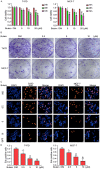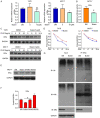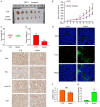ERα is a target for butein-induced growth suppression in breast cancer
- PMID: 33294263
- PMCID: PMC7716169
ERα is a target for butein-induced growth suppression in breast cancer
Abstract
Breast cancer (BCa) has the highest incidence and mortality among malignant diseases in female worldwide. BCa is frequently caused by estrogen receptor α (ERα), a ligand-dependent receptor that highly expressed in about 70% of breast tumors. Therefore, ERα has become a well-characterized and the most effective target for treating ERα-expressing BCa (ERα+ BCa). However, the acquire resistance was somehow developed in patients who received current ERα signaling-targeted endocrine therapies. Hence, discovery of novel anti-estrogen/ERα strategies is urgent. In the present study, we identified butein as a potential agent for breast cancer treatment by the use of a natural product library. We showed that butein inhibits the growth of ERα+ BCa both in vitro and in vivo which is associated with cell cycle arrest that partially triggered by butein-induced ERα downregulation. Mechanically, butein binds to a specific pocket of ERα and promotes proteasome-mediated degradation of the receptor. Collectively, this work reveals that butein is a candidate to diminish ERα signaling which represents a potentially novel strategy for treating BCa.
Keywords: Breast cancer; butein; degradation; estrogen receptor α; growth.
AJCR Copyright © 2020.
Conflict of interest statement
None.
Figures







Similar articles
-
Targeting proteasome-associated deubiquitinases as a novel strategy for the treatment of estrogen receptor-positive breast cancer.Oncogenesis. 2018 Sep 24;7(9):75. doi: 10.1038/s41389-018-0086-y. Oncogenesis. 2018. PMID: 30250021 Free PMC article.
-
Estrogen receptor alpha prevents bladder cancer via INPP4B inhibited akt pathway in vitro and in vivo.Oncotarget. 2014 Sep 15;5(17):7917-35. doi: 10.18632/oncotarget.1421. Oncotarget. 2014. PMID: 25277204 Free PMC article.
-
Modulation of estrogen receptor alpha protein level and survival function by DBC-1.Mol Endocrinol. 2007 Jul;21(7):1526-36. doi: 10.1210/me.2007-0064. Epub 2007 May 1. Mol Endocrinol. 2007. PMID: 17473282
-
Proteomics on malignant pleural effusions reveals ERα loss in metastatic breast cancer associates with SGK1-NDRG1 deregulation.Mol Oncol. 2024 Jan;18(1):156-169. doi: 10.1002/1878-0261.13540. Epub 2023 Nov 2. Mol Oncol. 2024. PMID: 37854018 Free PMC article.
-
Overcoming endocrine resistance in hormone receptor-positive breast cancer.Curr Oncol. 2018 Jun;25(Suppl 1):S18-S27. doi: 10.3747/co.25.3752. Epub 2018 Jun 13. Curr Oncol. 2018. PMID: 29910644 Free PMC article. Review.
Cited by
-
A SIX1 degradation inducer blocks excessive proliferation of prostate cancer.Int J Biol Sci. 2022 Mar 14;18(6):2439-2451. doi: 10.7150/ijbs.67873. eCollection 2022. Int J Biol Sci. 2022. PMID: 35414775 Free PMC article.
-
Integrating single-cell transcriptomics and machine learning to predict breast cancer prognosis: A study based on natural killer cell-related genes.J Cell Mol Med. 2024 Aug;28(15):e18549. doi: 10.1111/jcmm.18549. J Cell Mol Med. 2024. PMID: 39098994 Free PMC article.
-
Chalcone Scaffolds, Bioprecursors of Flavonoids: Chemistry, Bioactivities, and Pharmacokinetics.Molecules. 2021 Nov 26;26(23):7177. doi: 10.3390/molecules26237177. Molecules. 2021. PMID: 34885754 Free PMC article. Review.
-
Integrating Ethnobotany, Phytochemistry, and Pharmacology of Cotinus coggygria and Toxicodendron vernicifluum: What Predictions can be Made for the European Smoketree?Front Pharmacol. 2021 Apr 19;12:662852. doi: 10.3389/fphar.2021.662852. eCollection 2021. Front Pharmacol. 2021. PMID: 33953688 Free PMC article. Review.
References
-
- Bray F, Ferlay J, Soerjomataram I, Siegel RL, Torre LA, Jemal A. Global cancer statistics 2018: GLOBOCAN estimates of incidence and mortality worldwide for 36 cancers in 185 countries. CA Cancer J Clin. 2018;68:394–424. - PubMed
-
- Reis-Filho JS, Pusztai L. Gene expression profiling in breast cancer: classification, prognostication, and prediction. Lancet. 2011;378:1812–1823. - PubMed
-
- Rouzier R, Perou CM, Symmans WF, Ibrahim N, Cristofanilli M, Anderson K, Hess KR, Stec J, Ayers M, Wagner P, Morandi P, Fan C, Rabiul I, Ross JS, Hortobagyi GN, Pusztai L. Breast cancer molecular subtypes respond differently to preoperative chemotherapy. Clin Cancer Res. 2005;11:5678–5685. - PubMed
-
- Perou CM, Sorlie T, Eisen MB, van de Rijn M, Jeffrey SS, Rees CA, Pollack JR, Ross DT, Johnsen H, Akslen LA, Fluge O, Pergamenschikov A, Williams C, Zhu SX, Lonning PE, Borresen-Dale AL, Brown PO, Botstein D. Molecular portraits of human breast tumours. Nature. 2000;406:747–752. - PubMed
-
- Thomas C, Gustafsson JA. The different roles of ER subtypes in cancer biology and therapy. Nat Rev Cancer. 2011;11:597–608. - PubMed
LinkOut - more resources
Full Text Sources
